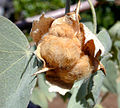Gossypium
| Gossypium | |
|---|---|

| |
| Flower of Gossypium herbaceum | |
| Scientific classification | |
| Kingdom: | Plantae |
| Clade: | Tracheophytes |
| Clade: | Angiosperms |
| Clade: | Eudicots |
| Clade: | Rosids |
| Order: | Malvales |
| Family: | Malvaceae |
| Subfamily: | Malvoideae |
| Tribe: | Gossypieae |
| Genus: | Gossypium L.[1] |
| Type species | |
| Gossypium arboreum | |
| Species | |
|
See text. | |
| Synonyms[1] | |
| |
Gossypium (/ɡɒˈsɪpiəm/)[2] is a genus of flowering plants in the tribe Gossypieae of the mallow family, Malvaceae, from which cotton is harvested. It is native to tropical and subtropical regions of the Old and New Worlds. There are about 50 Gossypium species,[3] making it the largest genus in the tribe Gossypieae, and new species continue to be discovered.[3] The name of the genus is derived from the Arabic word goz, which refers to a soft substance.[4]
Cotton is the primary
The origin of the genus Gossypium is dated to around 5–10 million years ago.
Cultivated cottons are perennial shrubs, most often grown as annuals. Plants are 1–2 m high in modern cropping systems, sometimes higher in traditional, multiannual cropping systems, now largely disappearing. The leaves are broad and lobed, with three to five (or rarely seven) lobes. The seeds are contained in a
Selected species
Subgenus Gossypium
- Gossypium anomalum Wawra & Peyr.
- Gossypium arboreum L. – tree cotton (India and Pakistan)
- Gossypium herbaceum L. – Levant cotton (southern Africa and the Arabian Peninsula)
Subgenus Houzingenia
- tetraploidcotton, alongside G. arboreum
- Gossypium thurberi Tod. – Arizona wild cotton (Arizona and northern Mexico)
Subgenus Karpas
- Gossypium barbadense L. – Creole cotton/Sea Island Cotton (tropical South America)
- Gossypium darwinii G.Watt – Darwin's cotton (Galápagos Islands)
- Gossypium hirsutum L. – upland cotton (Central America, Mexico, the Caribbean and southern Florida)
- Gossypium mustelinum Miers ex G.Watt
- Gossypium tomentosum Nutt. ex Seem – Maʻo or Hawaiian cotton (Hawaii)
Subgenus Sturtia
- Gossypium australe F.Muell (northwestern Australia)
- Gossypium sturtianum J.H. Willis – Sturt's desert rose (Australia)[8][9]
Formerly placed in genus Gossypium
- Gossypioides brevilanatum (Hochr.) J.B.Hutch. (as G. brevilanatum Hochr.)
- Gossypioides kirkii (Mast.) J.B.Hutch. (as Gossypium kirkii Mast.)
- Kokia drynarioides (Seem.) Lewton (as G. drynarioides Seem.)[9]
Gossypium genome
This article may be too technical for most readers to understand. (January 2011) |
A public genome sequencing effort of cotton was initiated
The public sector effort continues with the goal to create a high-quality, draft genome sequence from reads generated by all sources. The public-sector effort has generated Sanger reads of BACs, fosmids, and plasmids, as well as 454 reads. These later types of reads will be instrumental in assembling an initial draft of the D genome. In 2010, two companies (
Cotton pests and diseases


Pests
- Boll weevil, Anthonomus grandis
- Cotton aphid, Aphis gossypii
- Cotton stainer, Dysdercus koenigii
- native budworm, Helicoverpa punctigera, are caterpillars that damage cotton crops.
- Some other Lepidoptera (butterfly and moth) larvae also feed on cotton – see list of Lepidoptera that feed on cotton plants.
- Green mirid(Creontiades dilutus), a sucking insect
- Spider mites, Tetranychus urticae, T. ludeni and T. lambi
- Thrips, Thrips tabaci and Frankliniella schultzei
Diseases
- Alternaria leaf spot, caused by Alternaria macrospora and Alternaria alternata
- Anthracnose boll rot, caused by Colletotrichum gossypii
- Black root rot, caused by the fungus Thielaviopsis basicola
- Blight caused by Xanthomonas campestris pv. malvacearum
- Fusarium boll rot caused by Fusarium spp.
- Phytophthora nicotianae var. parasitica
- Sclerotinia boll rot, caused by the fungus Sclerotinia sclerotiorum
- Ashbya gossypii, Eremothecium coryli, (Nematospora coryli) and Aureobasidium pullulans
Gallery
-
A Gossypium hirsutum flower, lateral view, growing in Barcelona
-
The same G. hirsutum plant with the opening capsule
-
G. hirsutum flower with bumblebee pollinator, Hemingway, South Carolina
-
G. tomentosum boll
-
Integrated pest management bollworm trap at a cotton field in Manning, South Carolina
-
Natural biocontrol: predatory Polistes wasp looking for bollworms or other caterpillars on cotton plant in Hemingway, South Carolina
-
Cotton boll ready for harvest, South Carolina
-
Gossypium Sp. Brun -MHNT
See also
- Vegetable Lamb of Tartary, a European legendary plant remotely based on cotton.
References
- ^ a b "Genus: Gossypium L". Germplasm Resources Information Network. United States Department of Agriculture. 2007-03-12. Archived from the original on 2011-07-17. Retrieved 2011-09-08.
- ^ "Gossypium". Merriam-Webster.com Dictionary. Retrieved 2020-05-19.
- ^ ISBN 978-0-387-70809-6.
- ISBN 978-0-521-86645-3.
- S2CID 212822506.
- ^ PMID 12679546.
- ISBN 9780470660324.
- ^ "Gossypium". Integrated Taxonomic Information System. Retrieved 2011-09-08.
- ^ a b "GRIN Species Records of Gossypium". Germplasm Resources Information Network. United States Department of Agriculture. Archived from the original on 2015-09-24. Retrieved 2011-09-08.
- PMID 18056866.
- ^ APPDMZ\gyoung. "Monsanto and Illumina Reach Key Milestone in Cotton Genome Sequencing". www.monsanto.com. Archived from the original on 2016-02-01. Retrieved 2016-01-31.
External links
- Central Institute for Cotton Research – located in India.








